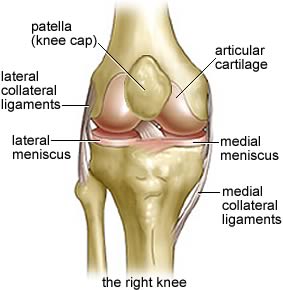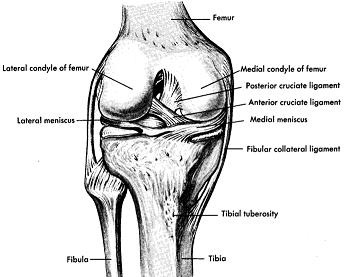
Broken Knee Injuries Symptoms, Diagnosis, and Treatment
A broken knee can be due to several injuries, like broken knee cap (patella fracture), or broken leg bones (tibia or fibula fracture) or thigh bone (femur fracture) near the knee joint. Road accidents, especially bike accidents, can cause the worst broken knee’s, with several knee fractures and torn knee ligaments and tendons. Such injuries are highly disastrous, and can have lifelong consequences. Even trivial knee injuries can be quite discomforting for a persons routine life. A broken knee is a serious knee injury, which causes severe disability and even deprives a person from any worthwhile employment for a prolonged period.
Importance of Knee Joint
Knee joint is the largest and most complex of all joints in the body. It is indispensable for walking and running, which are basic human necessities. Though, it appears like a simple hinge joint, just like in a door. But the structural complexity and the sophisticated phenomenon of locking and unlocking, make it an important dynamic support while standing as well as walking.

Picture 1: Knee Joint

Picture 2: Knee Joint – Ligaments and Menisci
The lower ends of femur and tibia take part in forming the knee joint along with the knee cap or patella (Picture 1). These bones are maintained in alignment by several restraining ligaments, like anterior and posterior cruciate ligaments (ACL and PCL), medial and lateral collateral ligaments, and the medial and lateral menisci (Picture 2). Several strong muscles, like quadriceps, and biceps femoris, control the movements of knee joint, and are also responsible for displacement of fractures near the knee joint. Hence, even a small alteration in the bony alignment, after a knee injury, severely affects the balance and gait of a person.
Types of Knee Injuries
The types of knee injuries depend on the location and nature of the knee injury as well as the specific bone injured. Intra-articular knee fractures which involve the portion of bone within the knee joint generally need aggressive treatment and later may lead to premature knee arthritis (post-traumatic knee joint arthritis). Floating knee is a type of broken knee, where lower end of femur and upper end of tibia are both broken and the knee as a whole becomes freely mobile and devoid of support.

Picture 3: Broken Knee on X-ray
- Femur Fracture of lower end – is a major knee injury, which can be undisplaced, comminuted, or intra-articular and is quite difficult to heal.
- Tibia Fracture of upper end – is a major knee injury, which can be undisplaced, displaced, or intra-articular.
- Broken Knee Cap – is one of the most common knee injuries and can be undisplaced, displaced, or compound.
- Broken Fibula near knee joint – is a minor knee injury, but concurrent injury to the peroneal nerve can also occur causing foot drop.
- Torn Knee Cartilage – can be due to meniscal knee injury or injury to the articular cartilage and is generally seen in intra-articular fractures.
- Torn Knee Ligaments – generally indicate less injury to bones, as the traumatic force gets exhausted in tearing the knee ligaments, but are extremely difficult to heal.
Knee Injury Symptoms
After an accident or a fall, many people are confronted with the question, “how do you know if your knee is broken? The answer is pretty simple, because a broken knee causes inability to stand or even move the knee slightly. Minor knee injuries may cause less severe symptoms, but are always tender to touch and profusely swollen. Regardless, of the severity a visit to the ER is necessary if any of the following symptoms of broken knee are present.
- Hemarthrosis or blood in the knee with no broken bone, occurs in torn knee ligaments or torn knee cartilage usually within 2 hours after knee injuries. It may also result in knee bruising if the knee injury is outside, but near the joint.
- Knee locking is a sudden painful block in knee movement and is due to interposition of torn knee cartilage or ligament parts between the articular surfaces after a knee injury.
- Knee swelling is due to inflammation of the soft tissues due to knee injuries.
- Knee instability is due to bone fractures or tearing of soft tissues and is a specific indicator of severe knee injuries.
- Knee pain is a non-specific sign of knee injuries and is present in all grades of severity.
The presence of a pale foot with tingling or numbness over foot is a sign of injured blood vessels and nerves, respectively, for which the person should be immediately brought to the ER of a nearby hospital, irrespective of the presence or absence of other symptoms of broken knee.
Broken Knee Cap
Broken knee cap is a serious knee injury, hence, one should not be looking for broken knee can remedies for recovery from broken knee cap. A visit to an ER for a broken knee cap x-ray should be done at the earliest, for any swelling after broken knee cap. The leg should be kept straight to reduce pain as well as prevent further damage to the broken knee cap. After confirmation of the fracture, a person may be given a broken knee cast or may have to undergo a broken knee surgery, for repair of the broken knee cap. Physical therapy exercises to rehabilitate broken knee cap consist of non weight bearing exercises during the immobilization phase or after broken knee cap surgery, to keep the muscles active and prevent stiffness.
Knee Injury Video
Video 1: Knee Injury while Skiing
Knee Injury Diagnosis and Treatment
Treatment of a knee injury begins by temporary stabilization of the broken knee, with the help of any splint or support, which keeps the knee straight. This prevents additional injury to the soft tissues around the broken bones and also reduces the internal blood loss, which facilitates early fracture healing. The patient should be rushed to the ER of a nearby hospital, where further investigations, like broken knee x-ray, and definitive management of the knee injury with a broken knee cast or broken knee surgery can take place.
Broken Knee X-ray
The earliest investigation in knee injuries diagnosis, is an X-ray of the knee. In growing children, knee injury diagnosis is difficult from a single x-ray. Hence, an x-ray of the normal knee may also be taken for diagnosing knee injuries in children. A broken knee x-ray (Picture 3) clearly shows bony knee injuries, and is especially useful in displaced fractures. For doubtful cases, a CT scan may be done for confirmation of the knee injury diagnosis.
MRI for Knee Injuries
MRI is generally done to diagnose a knee injury of soft tissues, like torn knee ligaments (ACL tear, PCL tear, collateral ligament tear, etc.), torn knee cartilage (meniscal tears), and tears of knee joint capsule. It is a 3 dimensional scan, which outlines the knee injuries anatomy for accurate knee injury diagnosis.
Broken Knee CT Scan with 3D reconstruction
3D-CT Scan is a highly sophisticated investigation, which artificially reconstructs the geometry of the bony structures of the knee joint. It is a 3 dimensional x-ray image, which gives the precise location and orientation of the bone fragments in a broken knee. Thus, it is very important in intra-articular and comminuted fractures of knee joint, and greatly helps in pre-operative planning of a broken knee surgery.
Broken Knee Cast for Knee Injuries
A broken knee cast or a cylinder cast, is a plaster of paris scaffolding, which is applied for temporary stabilization of a broken knee. It generally helps in keeping the knee immobilized in the straight position with a slight bend of 15 degrees. Walking along with a broken knee cast after knee injuries, has to be non weight bearing with crutches (Video 2).
Video 2: Walking with Broken Knee Cast
For minor injuries, like undisplaced fractures, it can be used for permanent treatment for 6 weeks, without the need for broken knee surgery. A knee brace, like long knee extension brace or hinged knee brace, is more preferred as is comfortable and gives similar results.
Broken Knee Surgery for Knee Injury
Surgical treatment for a broken knee has to be done urgently after diagnosis of knee injury, if the fracture obstructs blood supply of the leg or causes a nerve injury. Broken knee surgery is performed by an orthopedic doctor along with a vascular surgeon or plastic surgeon, to repair the damaged blood vessels or nerves, respectively. For knee injuries, with no such complication, broken knee surgery may be delayed for up to 3-4 days to allow the knee swelling to subside and perform investigations, like MRI or 3D CT scan.
Broken knee surgery primarily aims at preventing any shortening of the leg and achieving a rigid fixation with orthopedic screws and plates made of stainless steel or titanium. These implants are only to maintain the alignment of the broken bones and cannot sustain the loads of weight bearing. Hence, non weight bearing with crutches (Video 2), is mandatory for at least 6 weeks after broken knee surgery. Many times a single surgery is insufficient to completely solve all the issues after a broken knee and further surgeries may be needed for complications, like leg shortening, post-traumatic arthritis, etc. A person may also require knee replacement surgery after a few years for a terminally stiff and arthritic knee joint.
Knee Injury Exercises
Physical therapy in the form of broken knee exercise is important to improve the function of a stiff and weaken knee from the prolonged immobilization for knee injuries. Successful knee injury rehabilitation depends on a strict adherence to physical therapy guidelines.
Video 3: Exercises for Knee Injuries
Broken Knee Injury Recovery Time
The length of hospital stay for broken knee can vary from a few days to a month, depending on the severity of the knee injury. Common knee injuries of the knee cap or other bones around knee, generally heal within 6 weeks and the person is discharged from the hospital almost on the same or second day. Complicated knee fractures with several open wounds require intensive management for replacement and maintenance of adequate blood volume. Broken knee surgery has to be done in an emergency along with repair of other injured structures, like torn knee ligaments and tendons and broken knee cartilage. Knee injury recovery can take even up to 6 months, in a broken knee cast, followed by broken knee exercise to have a complete functional knee injury recovery.
Knee Injury Prevention
Protection of direct exposure to knees while skiing and driving, with the use of knee pads is an important measure in knee injury prevention. Car accidents and motorbike stunts are major sources of knee injuries, and hence, following traffic rules and accepted speed limits, generally helps in knee injury prevention as well as preventing other major mishaps.
Related Articles:
- Non Weight Bearing Exercises
- Broken Thumb Injuries Symptoms and Treatment
- Bone Fracture Healing
- Orthopedic Bone Screws
- Injured in a Car Accident